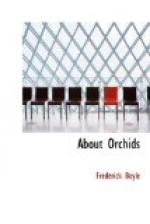But among Cypripediums, the easiest and safest of all orchids to hybridize, East Indian and American species are unfruitful. Messrs. Veitch obtained such a cross, as they had every reason to believe, in one instance. For sixteen years the plants grew and grew until it was thought they would prove the rule by declining to flower. I wrote to Messrs. Veitch to obtain the latest news. They inform me that one has bloomed at last. It shows no trace of the American strain, and they have satisfied themselves that there was an error in the operation or the record. Again, the capsules secured from very many by-generic crosses have proved, time after time, to contain not a single seed. In other cases the seed was excellent to all appearance, but it has resolutely refused to germinate. And further, certain by-generic seedlings have utterly ignored one parent. Zygopetalum Mackayi has been crossed by Mr. Veitch, Mr. Cookson, and others doubtless, with various Odontoglossums, but the flower has always turned out Zygopetalum Mackayi pure and simple—which becomes the more unaccountable more one thinks of it.
Hybrids partake of the nature of both parents, but they incline generally, as in the extreme cases mentioned, to resemble one much more strongly than the other. When a Cattleya or Loelia of the single-leaf section is crossed with one of the two-leaf, some of the offspring, from the same capsule, show two leaves, others one only; and some show one and two alternately, obeying no rule perceptible to us at present. So it is with the charming Loelia Maynardii from L. Dayana x Cattleya dolosa, just raised by Mr. Sander and named after the Superintendent of his hybridizing operations. Catt. dolosa has two leaves, L. Dayana one; the product has two and one alternately. Sepals and petals are alike in colour, rosy crimson, veined with a deeper hue; lip brightest crimson-lake, long, broad and flat, curving in handsomely above the column, which is closely depressed after the manner of Catt. dolosa.
The first bi-generic cross deserves a paragraph to itself if only on that account; but its own merits are more than sufficient. Sophro-Cattleya Batemaniana was raised by Messrs. Veitch from Sophronitis grandiflora x Catt. intermedia. It flowered in August, 1886; petals and sepals rosy scarlet, lip pale lilac bordered with amethyst and tipped with rosy purple.




